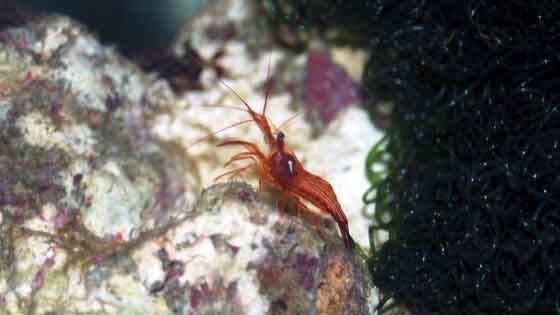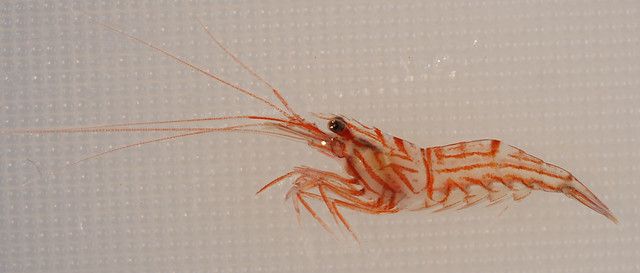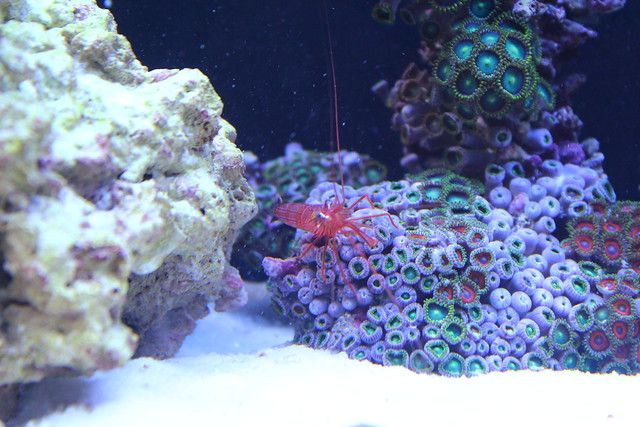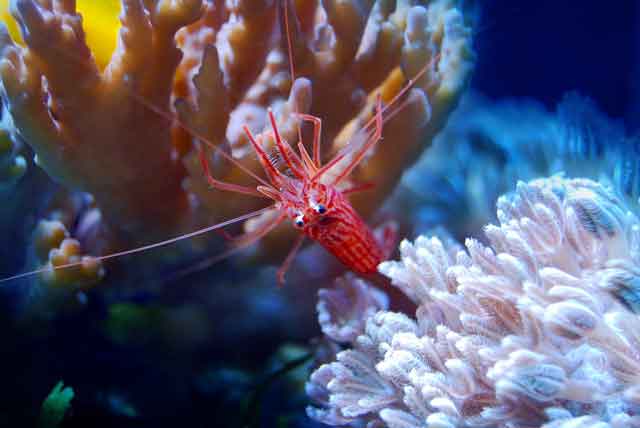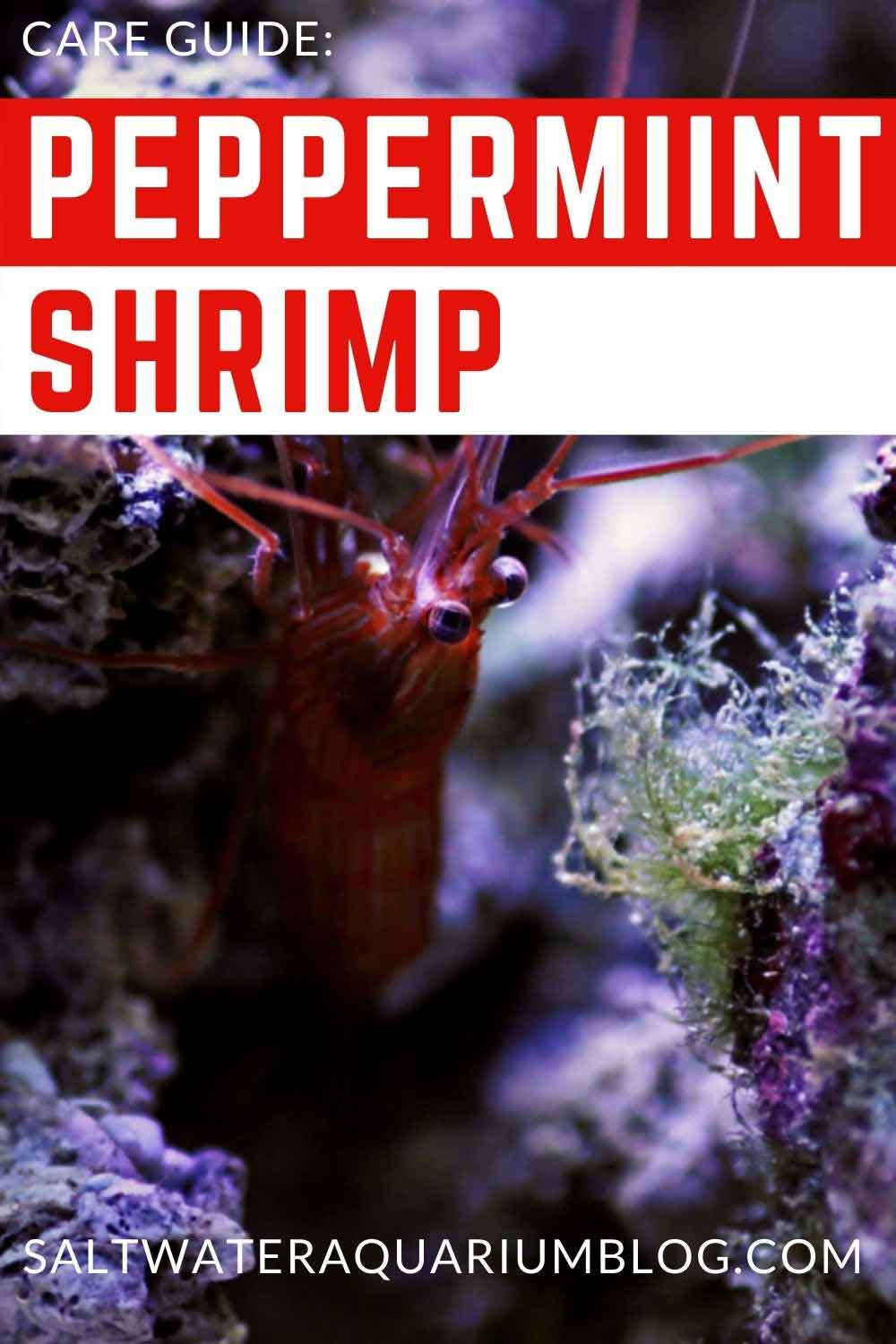[ad_1]
Peppermint shrimp are a brightly colored, inexpensive saltwater reef shrimp species that are often recommended to help control aiptasia anemone populations. But they are also a fun, interesting, easy-to-care for invertebrate that can add some color and variety to your reef tank.
Let’s dive a bit deeper into what makes them interesting, how to care for them, what they are compatible with and whether or not you can add them to your reef tank safely.
Peppermint shrimp: Interesting facts and behaviors
A potential member of your clean-up-crew
One of the first and perhaps most straightforward interesting behaviors of the peppermint shrimp is that they “count” as a somewhat less traditional member of the clean-up-crew. When I think about the traditional clean-up-crew members: hermit crabs, Cerith snails, Nassarius snails, and even Serpent starfish tend to come to mind first.
But given the facts that they usually cost less than $10 and will spend their time crawling over your substrate all day picking through the detritus and algae filaments looking for a bite to eat–they are certainly an appropriate and eligible member of the clean-up-crew.
Peppermint shrimp are an inexpensive cleaner shrimp
Peppermint shrimp are also technically considered to be a cleaner shrimp, meaning that they will potentially climb over willing fish volunteers, picking off parasites and damaged or loose scales (Sprung 2001).
I’d like to share that I have personally never observed this behavior in my own tanks, having purchased probably ~10+ over the years. However, here is video evidence of them cleaning someone’s hand in an aquarium, which is essentially…the same behavior. I just provide that personal observation to help set expectations that cleaning is perhaps one behavior you may observe but potentially not the main behavior.
Although I have to say, I really do want some shrimp to clean my hands. That looks awesome.
Peppermint shrimp: natural predator of aiptasia anemones
As mentioned earlier, one of the most common reasons peppermint shrimp are actively sought out and added to a reef tank is because they are natural predators of the dreaded aiptasia anemones.
If you haven’t heard about aiptasia before, they are (typically) undesirable, rapidly reproducing hitchhiker that absolutely thrives in reef tanks. They grow so prolifically that they can spread to plague proportions, and once you have them, nobody will want to swap coral frags with you :(. They are like ‘contagious weeds’ in your reef tank and are a pain to get rid of.
The good news here is that the peppermint shrimp loves to eat them. So if you add a few peppermint shrimp to the tank, they will seek out and dine on the problem. Which is a fascinating-to-watch, non-chemical way to keep the plague population under control.
Learn more about aiptasia anemones here.
Scientific name and common names
Peppermint Shrimp have a bunch of other popular names including Candy Cane shrimp, Caribbean shrimp, Caribbean cleaner shrimp, and Veined shrimp. These relatively small and peaceful shrimp are most commonly reported to be from the genus and species Lysmata wurdemanni, but you can also find Lysmata ankeri, Lysmata boggessi and Lysmata rafa online or in stores.
Size
Peppermint shrimp are small. Fully grown adults are generally only ~2 inches in size.
Peppermint shrimp: reef safe or not?
In my own personal experience (probably 10 different peppermint shrimp over a span of way too many years to want to admit), they have been completely reef safe. If you read the care guide descriptions on popular websites like LiveAquaria.com, you will similarly note they indicate (at least the ORA captive bred varieties) will not eat corals.
However, as is often the case with fish or invertebrates on the reef, the soft, fleshy polyps of some coral species can be too much to resist, for some individuals.
A quick scan on YouTube found several different accounts of peppermint shrimp caught in the act. Here’s one, front and center, you can actually see the shrimp yank out and eat the polyps.
So, buyer beware. There is often a debate, at times like this, about whether the coral is already dying and the shrimp is just cleaning up the mess like shrimp do, or whether it’s a camel shrimp or some coral-munching variety, but the unfortunate truth is that it is not uncommon to hear about it.
Difficulty level: easy to care for
For the most part, Peppermint Shrimp is an easy species to care for. They aren’t picky eaters and will climb around the substrate in your tank, feeding themselves and tidying up as they do.
Lifespan
Peppermint Shrimp are a hardy species that can live up to two years, with some luck and success.
Compatibility
Perhaps the first, and biggest compatibility issue when keeping the Peppermint shrimp is to make sure shrimp are not on the menu. I know I enjoy the taste of shrimp, and so do most fish with mouths large enough to accommodate them into their digestive tracts, like the Marine betta, Dogface pufferfish, or Picasso triggerfish
And you even have to watch out for small-mouthed hawkfishes, which will consume a shrimp even if larger than their mouths.
The best tanks to add a Peppermint shrimp to have peaceful, herbivorous species or planktivores/omnivores who tend to think of shrimp as friends, not foods, like coral beauty dwarf angelfish, pajama cardinalfish, mandarin goby, yellow tang, etc.
These attractive shrimp are peaceful and can be kept with other shrimp, including other members of the same species.
Peppermint shrimp are famous for their willingness to eat aiptasia anemones. Suffice it to say, they are incompatible with aiptasia, from the anemone’s point of view.
According to Sprung 2001, they are incompatible with tridacnid clams.
Feeding
It seems like peppermint shrimp have two ‘modes’: hiding and feeding. They will spend some of their time hiding in the cryptic or shaded areas of the tank, under rock ledges, etc., but when they are out and about in the tank, they seem to always be picking and tiny morsels in between coral polyps, on the rocks, on the sand, pretty much everywhere.
Unless your tank is particularly nutrient sparse (a brand new tank or an SPS tank where you try really hard to keep the nutrient levels low), they will likely keep themselves well-fed. You may even find them snagging some frozen brine shrimp, mysis shrimp, or other food at mealtimes.
Preparing Your Tank
Peppermint Shrimp are pretty easy to place in a tank thanks to their small size. If you are just planning on keeping Peppermint Shrimp, then you can have a minimum tank size of just ten gallons. If you can multiple Peppermint Shrimp, then it may be wise to add an extra five to ten gallons per shrimp. For the most part, adding them to a pre-existing tank would be much of a problem since they won’t take up much room.
You should ensure that the Peppermint Shrimp can easily scavenge and have some small caves to hide inside of. They are particularly happy in tanks that include live rock for them to live in and scavenge on. They can work with pretty much any type of substrate and are happy with live rocks. Once they are placed inside of a peaceful tank, they are hardy and won’t cause you much trouble.
If you are raising small Peppermint Shrimp, then keep in mind that strong filtration can suck them up. This can be a problem in smaller tanks where the species is closer to the filter intake. You should also be careful if you are planning to add in multiple Peppermint Shrimp. Make sure they will have enough area to claim their own territory to keep them from fighting.
Where they spend their time in the tank
As mentioned a bit earlier, shrimp are food for a lot of marine predators. So it may not surprise you to know that when you first bring them home from the local fish store and introduce them to your tank–they may have some trust issues–and be a bit shy. They generally prefer the safety of the shadowy ledges of live rock over being out in the open, but they do venture out to eat and hang out.
Regardless, they are almost always ‘attached’ to some structure. Open water swimming was rarely observed in my tank–reserved for rapid escapes when spooked rather than primary locomotion.
Reproduction
Peppermint shrimp have been successfully raised in captivity. There is even a book dedicated to the topic:
ORA and other aquaculture suppliers offer them–which is a great/preferred option over locally collected specimens.
Obtaining a pair capable of breeding is quite easy since Peppermint Shrimp are simultaneous hermaphrodites. If you get a shrimp carrying eggs (take a look at the ‘swimmers’ under their tail, that’s where they keep them), or have two or more shrimp that mate in your tank, then you will have babies in your tank…very briefly.
The babies, of course, are called larvae, and the larvae will very likely be on the menu of any of the planktivorous fishes in your tank, or even the parent shrimp.
As mentioned earlier, raising the larvae successfully has been done, methods are established, but you likely won’t be successful without deliberate efforts to capture the larvae, culture your own foods (phytoplankton, rotifers, copepod larva, baby brine shrimp, etc.), and a separate grow-out tank.
The shrimp generally take a little over thirty days to metamorphose into juveniles and settle in their new tank.
For more information about breeding peppermint shrimp and securing the live cultures necessary, check out: Algaebarn.
Conclusion
Peppermint Shrimp are a hardy, easy to breed species that are often added to keep the population of aiptasia anemones down. The biggest challenge you will face is having to pick tank mates that won’t turn the crustaceans into a midnight snack and hope you don’t get one of the individuals who plan to snack on your LPS.
For more information about peppermint shrimp or other interesting invertebrates
Check out this video, for more information about Peppermint Shrimp
Here are a few other articles to jump to, related to the peppermint shrimp:
References
Kirkendoll, April. How to Raise & Train Your Peppermint Shrimp, 2nd Edition. Lysmata Publishing. 2008
Sprung, Julian. Invertebrates: A Quick Reference Guide. Ricordea Publishing. Miami 2001.

[ad_2]
Source link

